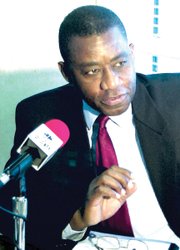By NEIL HARTNELL
Tribune Business Editor
nhartnell@tribunemedia.net
The Government’s $4.416 billion national debt is “likely to get worse before its gets better”, a key Ministry of Finance adviser telling Tribune Business that key short-term financing facilities have been “maxed out”.
James Smith, a former minister of state for finance who is now advising the Christie administration, said the Government’s Royal Bank of Canada (RBC) overdraft facility had been “maxed out and doubled to $200 million”, while a short-term credit facility provided by the Central Bank of the Bahamas was also used up.
Echoing a warning by the Central Bank, namely that the 2012-2013 Budget measures were “forecasted to produce a deterioration in the overall fiscal deficit and debt position”, Mr Smith said the Government’s short-term credit facilities were “further gone than anyone thought”.
He told Tribune Business that the worsening of the Government’s financial position would “have been set in train several months ago” under the former Ingraham administration, via contractual commitments and payments falling due.
“It’s likely to get a little worse before it gets better,” Mr Smith told this newspaper. “A lot of the short-term facilities were probably further gone than anyone expected.”
He added that one such facility was a “very peculiar thing in the Bahamas, and Parliament is not very seized of it”.
While the Budget debate took place in the lower and upper chambers, Mr Smith said: “The Central Bank can issue, on a short-term basis, credit up to 10 per cent of the amount projected.”
Suggesting that this amounted to a potential figure of around $150 million, Mr Smith, a former Central Bank governor, added of the facility: “That’s all maxed out. They don’t see that coming down because it does not need Parliamentary approval.”
As for the Government’s RBC overdraft facility, this in the past had typically reached its limit at month’s end, covering civil service salary payments, and was then reduced and replenished by incoming revenues.
But, with revenues hit by the recession, the latter “wasn’t happening”, according to Mr Smith.
“So the overdraft facility was maxed out and doubled to $200 million,” he added.”We’re seeing things like that. It stays there [$200 million], and you have to negotiate to keep it there. That makes it worse than you think.
“Apart from having loan facilities to the max, the short-term thing to get out of it has also been used up. Short-term Treasury bills are also maxed out.”
As a result, Mr Smith said the Government had to get revenues back to normal levels, and reduce spending in line with its income.
This did not happen during the 2011-2012 fiscal year, the Central Bank reporting that for the first 10 months to end-April the deficit widened by $55.6 million or 27 per cent, year-over-year, to $261.5 million.
Again, the figures appeared to indicate a spending problem, for while total revenues for the period increased by 4.7 per cent or $54.4 million to $1.202 billion, total expenditure increased at a greater rate - by 8.1 per cent or $110 million to $1.464 billion.
“Under revenues, tax receipts grew by $17 million (1.6 per cent) to $1.063 billion, supported by a 23.6 per cent surge in international trade taxes, which was due primarily to increased proceeds from excise taxes,” the Central Bank said.
“Non-tax collections also rose by $19.8 million (19.4 per cent) to $121.6 million, attributed to an almost doubling in income from other ‘miscellaneous’ sources, which benefited from a timing-related receipt of dividend payments from a local utility company.
“In terms of spending, broad-based increases were registered for all categories, led by a more than two-fold hike in net lending to $89.6 million, attributed to a single public sector entity,” the regulator added.
“In addition, current outlays grew by $40.3 million (3.5 per cent) to $1.21 billion, underpinned by an 8.7 per cent rise in consumption expenditures, based on increases in purchases of goods and services. Capital spending firmed by $22 million (15.5 per cent) to $163.9 million, owing to a 12.8 per cent advance in infrastructure outlays.
“Financing for the deficit was primarily obtained from domestic sources, via the issuance of $160 million in Registered Stocks, $154.6 million in short-term borrowings and $71.2 million in project-based external loans. At end-May 2012, the Direct Charge [debt owed by central government] stood at $3.88 billion, a gain of $73.4 million (1.9 per cent) over end-2011.”
Mr Smith told Tribune Business that while the Government had both a spending and revenue problem, the latter position was “much worse than it looks” due to a failure to ‘back out’ gains from one-off transactions that had occurred in the past three consecutive fiscal years.
These included receipts from the BORCO and South Riding Point purchases, Baha Mar deal and BTC privatisation.
“They came in so consistently over a three-year period that they fed into what appeared to be resurgent revenue, rather than being backed out,” Mr Smith said.
“It means revenue is really down, expenditure is very high and revenue is not performing.
“The Government’s starting pretty low in terms of the levers you have to pull on - the expenditure controls and revenue boosting. We’ve done as much as we can without radical reform.,”
Mr Smith said the Bahamas’ credit rating downgrades over the past several years would also negatively impact its borrowing rates on the international capital markets.





Comments
nicolae 11 years, 3 months ago
The debt is high. I am sure that this will increase the taxes. Maybe they should try to hire inteligent people like http://www.independent.co.uk/voices/c...">John Studzinski as advisers in order to help them reduce the debt.
Sign in to comment
Or login with:
OpenID